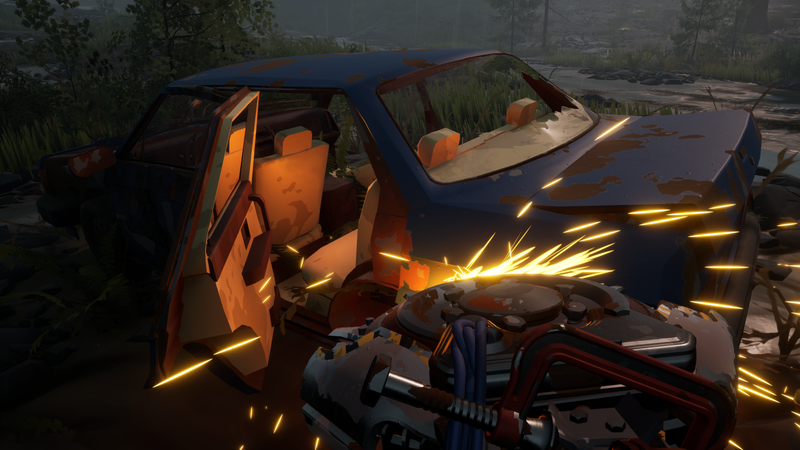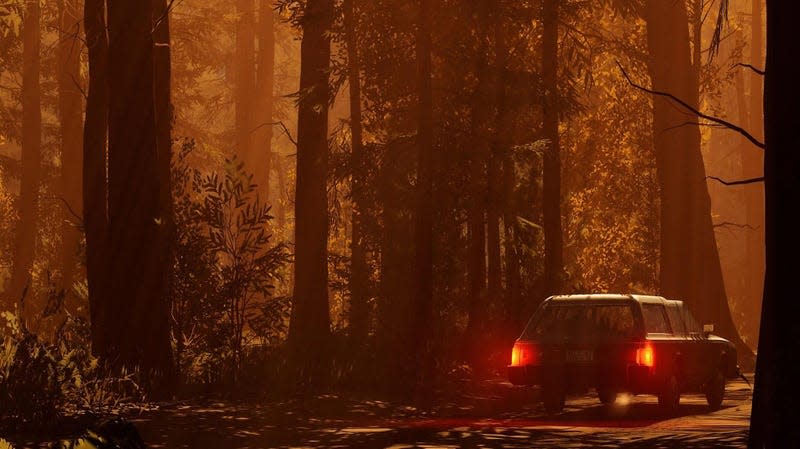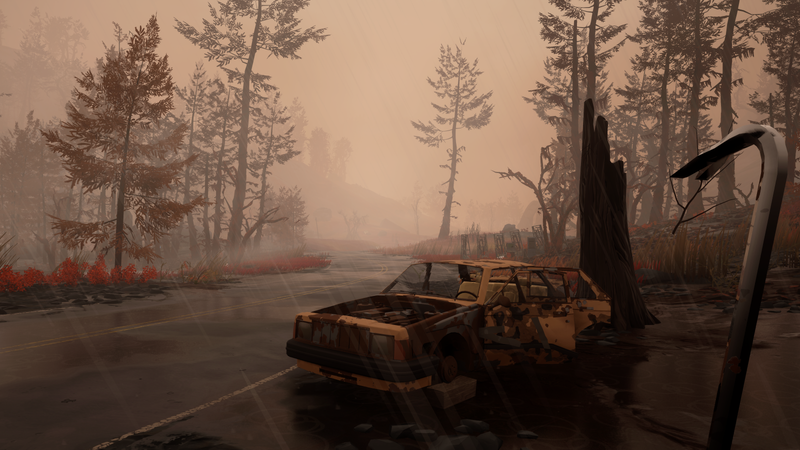You Haven't Played A Survival Game Like This Creepy Car One
You hop into a rundown station wagon in the Pacific Northwest and start driving down a beat up road as rain begins to pitter patter across the windshield. Trapped in a paranormal playground called the Olympic Exclusion Zone, strange anomalies appear outside the windows. Rock formations suddenly jut out of the middle of the road. Glowing beams distort the properties of physics and toss the car around like a child’s plaything. Eventually strange machines descend from the ether and pursue you with menace.
If you’re lucky you can collect some scrap, discover a few secrets, and capture enough energy from mysterious pillars littered across the terrain to activate a gateway back to the safety of your garage before things really start to go sideways. Once you spot a red storm coming over the horizon in the rear-view mirror you know it’s time to get the hell out. A tumbleweed-sized mechanical burr latches onto your hood. Then a buzzsaw slashes through the car door. Electric crawlers, floating abductors, and other strange creatures spewed forth from the Zone start circling.
Read more
You free the car from a few of them and smash the gas pedal only to realize you’ve got a flat tire. You pivot to being a solo pit crew but it’s too late. The storm envelops you and the lights are starting to go out. With its last ounce of battery power the station wagon teleports you both back to the garage while some of what was collected during the expedition is abandoned to the Zone. Now it’s time to go back to the drawing board, repair the station wagon, and prepare for the next voyage out into the unknown.
Based on a recent hands-off demo and group interview with indie developer Ironwood Studios, this loop is the foundation of Pacific Drive, a crafting survival “road-like” aiming to come to the PS5 and PC before the end of 2023. Frequently exhausted with the “grindset” of many modern survival games, I’m still intrigued by the game’s combination of walking-sim exploration and high speed car chases, and an absolute sucker for its moody atmosphere and conspiratorial horror sensibility. If those two things can be elegantly combined, Pacific Drive could be something special.
A new kind of roguelite
Initially revealed in a PlayStation State of Play showcase last September, the game has shades of 2016’s hiking adventure Firewatch if you swapped the walkie-talkie for an ‘80s station wagon that functions like the love child of Back to the Future’s Delorean and Ghostbusters’ ECTO-1. However, unlike Campo Santo’s narrative-driven hit whose protagonist was voiced by Mad Men actor Rich Sommer, Pacific Drive won’t be nearly as chatty.
“We’ve got a silent protagonist,” lead designer Seth Rosen said during a preview session earlier this month. “Like we wanted to not kind of get in the way of the player’s ability to form a relationship with their car because that’s, that’s really the main relationship in the game.”

Inspired by the game’s designers’ own fondness for old Volvos and Buick LeSabres, the station wagon is controlled from within the driver’s seat like in Cyberpunk 2077 rather than in the standard first-person perspective players might be familiar with from racing games like Forza Horizon 5. Information about the structural integrity of the car, surrounding anomalies, and changing hazards are displayed directly on the dashboard while a built-in radio plays music or messages from other characters caught out in the Zone.
You and the station wagon take care of each other out on the road while scavenging for resources and clues. Nodes on a map let you plot out discrete points of interest to travel to, while the levels themselves are procedurally generated to create a sense of novelty and reinforce the idea that the Zone is constantly shifting. You’re also frequently getting in and out of the car as you find scrap to salvage or locations that might be home to audio logs and other collectibles.
The developers said they put a lot of work into making sure the levels still follow certain rules so that, for example, you don’t get stuck on trees, boulders, or ditches while offroading. But they also feel that unscripted moments created a more intimate relationship between the player and their car. The car’s evolving physics will be a duet between the hazards that spawn and your own upgrades, while the simulation is robust enough to let your car inch forward with only two wheels if conditions allow rather than instantly breaking if certain basic conditions aren’t met.

“What we found as we were play testing is what players were really getting attached to were the moments that they were discovering themselves where, you know, they were in a crazy storm and they forgot to put on their handbrake of their car and the car started to roll downhill and then an anomaly started chasing them,” said creative director Alexander Dracott.
Can you pet the car?
Back at the garage you can then use what you’ve collected from an expedition not only to make repairs but also to upgrade machinery, craft new accessories for the car, and modify its appearance with things like new paint colors. Can you pet the car? I asked and the answer is unfortunately no. “We definitely have some other little things that you can do with your car to just reinforce that positive relationship because we don’t have hands in the game,” Dracott said. There will be bobbleheads you can play with on the dash, and possibly other little touches by the time the game is finished.
As the game progresses you’ll chart highways that help you bypass long stretches between older levels, and the developers are planning for each expedition to take close to an hour depending on how thorough or greedy you want to be. They’re more tight lipped about what the larger mystery is behind the Zone, and the answers that might be found there. They were much more interested in talking about what players will bring to the game and their cars over the course of their playthroughs.

“Being literally behind the wheel and then having that experience of interacting with with the computer and the different knobs and dashes and dials and you know, flipping on the windshield wipers and that kind of thing—that for us was part of what made those relationships strong and that’s what we’ve been designing the game around at the moment,” Dracott said.
Case-in-point, rather than scripting certain music for specific moments during an expedition, the developers decided to allow players the option of picking their own music off the radio or from tracks found out in the world. “We just don’t know what’s kind of going on with the player,” Dracott said. “They may be tuning into the radio and a song may sound amazing during the storm.”
Scored by composer Wilbert Roget II (Call of Duty: WWII), Pacific Drive will also feature over 15 licensed songs, though it’s not yet clear what they’ll be. The game is shaping up to be a nostalgic road trip simulator as much as anything else then. Despite the sci-fi elements and high tech upgrades, it revels in analog interactions from the click of opening the car door to the inefficient but satisfying crank of engaging the hand brake.
“Authentic is the first word that comes to mind,” Dracott said. “The reality is we really just wanted to connect you to the car. And that meant being in first person when you’re doing the part swapping as opposed to doing it from a menu. It also means being literally behind the wheel and then having that experience of interacting with the computer and the different knobs and dashes and dials and flipping on the windshield wipers. That for us was part of what made those relationships strong and that’s what we’ve been designing the game around.”
More from Kotaku
Sign up for Kotaku's Newsletter. For the latest news, Facebook, Twitter and Instagram.
